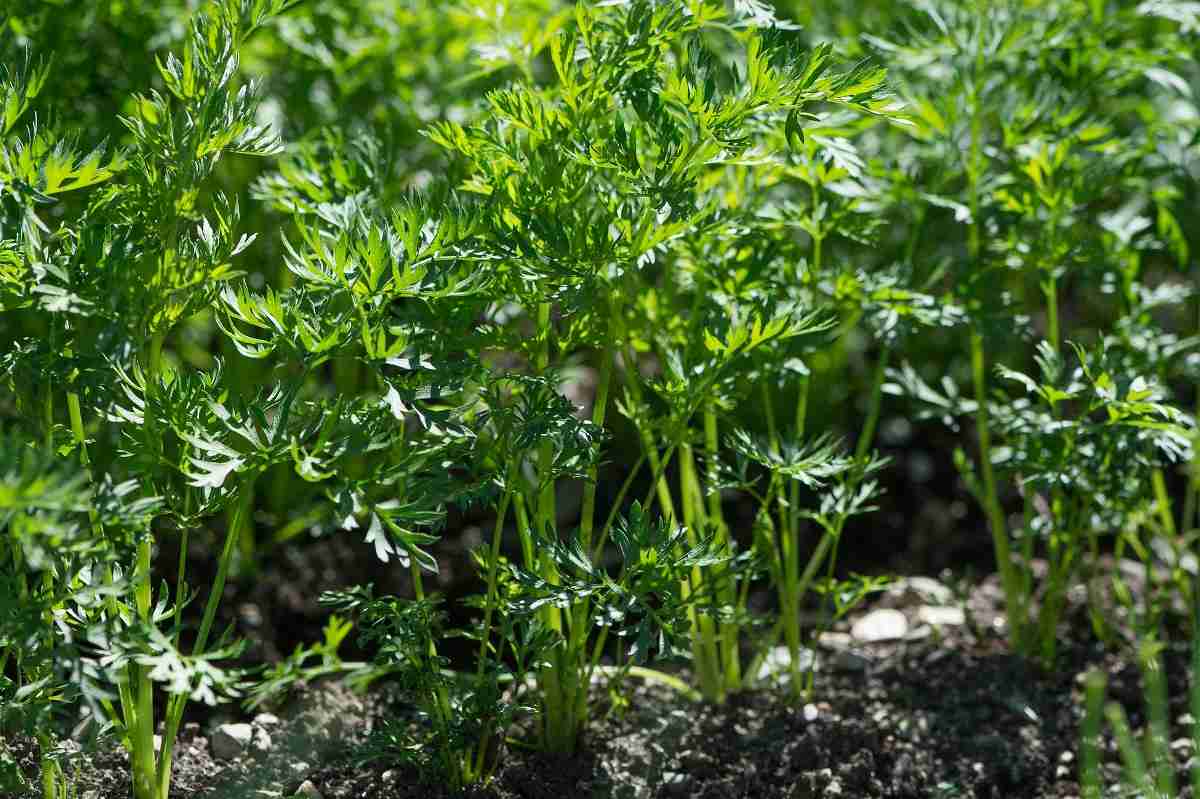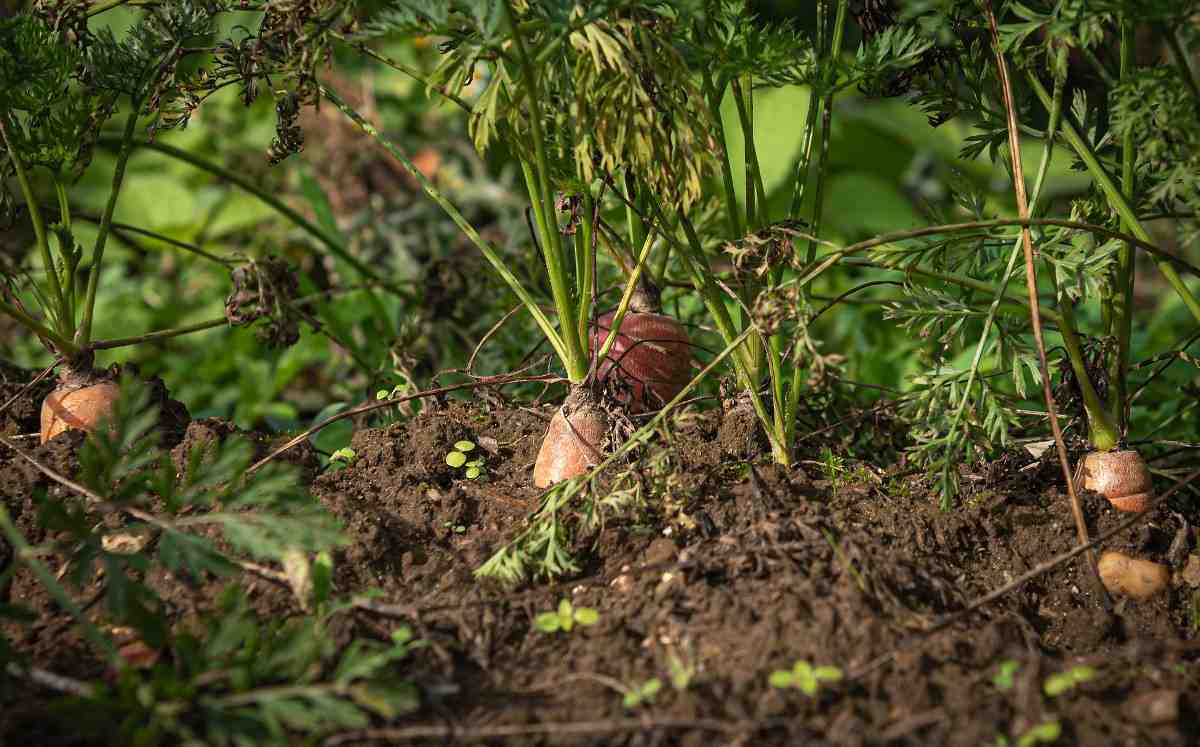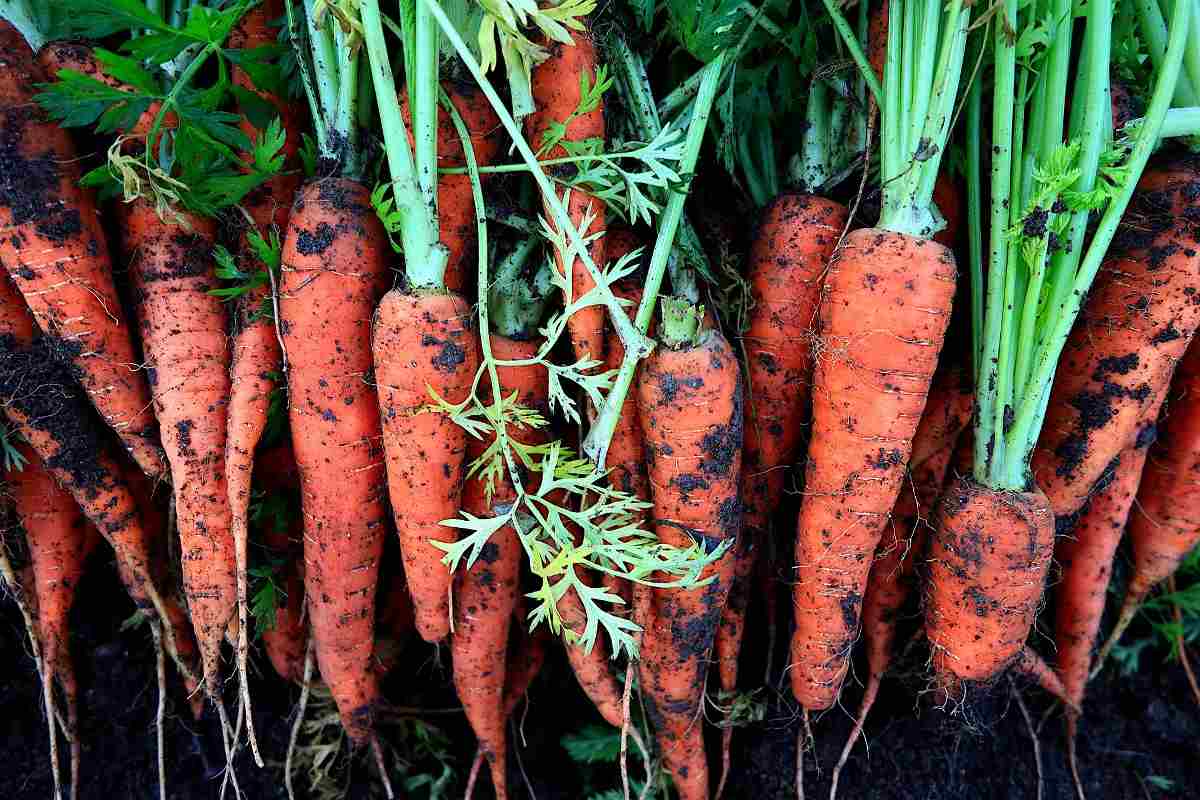Introduction to growing Organic Carrots in Backyard
Growing Carrots in the backyard is easy and can provide colour, flavour, and nutrition to an organic gardener’s diet. This popular root vegetable performs best in cool temperature levels between 15-21°C and may be planted as soon as your soil can be worked in early spring. Carrots are perfect for backyard vegetable gardens. Your container must be at least 12-inches deep, to accommodate the developing roots. Select one with adequate drainage, and make several holes in the bottom of the vessel of your choice.
A step by step guide to growing organic Carrots in backyard
Carrots grow well in backyard gardens, but soil preparation is far more arduous work. Backyard garden soil needs to be well-tilled and amended thoroughly with organic material so that Carrots can grow and develop their fruits deep within the ground. The soil must be tilled to a depth of at least 12 inches for this root vegetable to thrive. Organic gardening has several advantages over a chemical-based approach; the crops produced are tastier and healthy. Even though the roots are growing underground, Carrot tops need full sun to light shade for the Carrots to grow quickly.
Soil required for growing organic Carrots in the backyard
Carrots need loose well-drained soil. They will fork and deform if they meet with the slightest resistance, like rock soil or hard soil. If you can’t provide loose soil in a vegetable garden, consider growing Carrots in a container. Carrots do not grow well in highly acidic soil and soil pH level in the range of 6.0–6.8 is recommended. Getting your soil right basically involves adding organic matter in the form of garden compost, good quality manure, and homegrown green manure, seaweed meal or fresh seaweed.

Select Carrot seeds with the right root size and shape to suit your soil. If soil is heavy or rocky, grow short rooted Carrot varieties. Other supplies you may need include compost, rake, sand, organic mulch, deep containers and a garden trowel.
Different varieties of Carrots for growing in the backyard
Like many other vegetables, Carrot varieties can be mainly divided into early, main-crop, and storage varieties. They come in several types that vary in size and shape, as well as a range of colours, from the classic deep orange to purple, white, yellow, and red. Carrots come in a different variety of colours. There are the traditional orange Carrots, but you can also grow purple Carrots, white Carrots, and even yellow Carrots.
The other types of Carrot varieties are the ball-type Carrots and the long slender type Carrots. The ball-type Carrots are the Chantenay, Miniature, or Danvers. These types of Carrots can handle heavy clay soils and the long slender type Carrots are the Nantes and Imperator. These need loose sandy soil to thrive.
Nantes Carrot Varieties – Nantes varieties are the easiest Carrots for home gardeners to grow. Some of the Nantes varieties are Scarlet Nantes, Bolero, Nelson, Yaya, Napa, and Touchon
Chantenay red cored – An heirloom variety that grows 5-6 inches long, ‘Chantenay Red Cored’ is perfect for 8-inch-deep containers.
Danvers – Danvers grows 7-8 inches long. This is an excellent choice for those who prefer long, slender Carrots over short and stubby ones.
Little finger – These tiny treats grow just 3 to 4 inches long, so you can grow dozens of them in a wide, 8-inch-deep rectangular planter.
Other varieties are Top weight (best virus and pest immunity species in the world), Bolero, Juwarot (Healthiest Carrot), Gold Nugget, and Yellowstone, Redland (First Grower), Majestic Red (Imperator), Baby Bell (Small), King Chantenay.
Picking the perfect spot to growing organic Carrots in the backyard
Select a backyard site in full sun or very light partial shade and prepare the soil with ample amounts of organic compost. Carrots will reach perfection when planted in deep, good-textured soil that is free of stones and debris. Grow the long varieties only if you can provide this type of soil and choose shorter varieties if your soil is heavy or stony.
You can plant Carrots in the ground, in raised beds, and even in containers. If you are limited on backyard space then growing Carrots in a container might be a good option. Plus it ensures you can grow them where they can get enough light. Carrots need 6 to 8 hours of sunlight each day to grow well.
Container size for growing organic Carrots in the backyard
Carrots are among the easiest vegetables to grow indoors, and indoor Carrot gardens will be attractive as well as functional. You can grow baby Carrots in any size container, but longer plant varieties need deeper pots. Select a pot that is at least 8 inches deep to grow short or half-long varieties and one that is 10 to 12 inches deep for standard length Carrots. Fill the pot with good quality potting soil to within an inch of the top and now you are ready to plant Carrots.
Get planting materials for growing organic Carrots in the backyard
Get all that is needed to start planting such as containers, potting soil, gloves, trowel, seeds, etc. When shopping for containers, try finding those that are wider and shorter. Since most of the varieties will not reach more than 5 inches long, a container that is twice that would work fine. You want to have as much surface area as possible. When buying potting soil, every gardener has their preference, but it is best to buy the soil mix for container use. And prefer to not have any additives such as fertilizer when going vegetables because growing organically is preferred and controlling the amount of application is important.
Carrot spacing/Carrot plant distance
In case if you miss this: How To Grow Tomatoes At Home.

When sowing Carrot seeds, proper spacing is essential. Space the Carrots 1 to 2 inches apart until they are about 1/2 inch in diameter and then thin to 3 inches apart. But don’t throw away those thinned Carrots use them in cooking. Carrots need a steady supply of water and plant seeds a half-inch deep and one inch apart per row. We recommend planting Carrots in rows that are spaced with at least 1 foot between each row. In loose well-draining soil and space them 1-inch apart and keep rows 15-inches across from each other.
Container care for growing organic Carrots in the backayrd
First, fill the container with organically rich potting soil. A purchased product specifically for vegetables will have a good combination of ingredients like peat moss, sand, and vermiculite. You want to be sure that the potting medium is smooth, light, and airy, for adequate drainage and optimal plant root growth.
Carrots do best in soil with a high potassium content which encourages plant root growth. Be cautious about the nitrogen level in soil, as this will promote foliage growth, which is not our goal. You can use soil from the garden, but it’s recommended that you conduct a soil test and amend it as necessary. Potted Carrots need regular watering. Be sure to water at the soil level, and not over the leafy tops, to avoid problems with rot and keep the soil moist, but not soggy, and never allow it to completely dry out.
Sowing Carrot seeds
Sow seeds 6 mm deep, leaving 5 cm between seeds and about 30 cm apart. When seedlings reach 2.5 cm in height, thin them to a final spacing of about 7.5 cm between plants by snipping with scissors and this avoids damaging plant roots.
Carrot seed germination
Carrots take between 70 to 80 days to reach full maturity, so patience is required to prevent you from getting over eager and harvesting too early. It can take Carrot seeds as long as 10 days to fully sprout (sometimes longer if the seeds are covered in clay) so patience and careful watering are needed during this time. Carrot seeds germinate best when soil temperatures are close to 15 and 21°C.
How to plant Carrots in the backyard
Carrots must be planted around 1cm deep in the soil. If you are planting the crop in multiple rows, make sure that each plant is at least 15cm apart from each other so they have enough room to grow. Sow Carrot seeds thickly in rows 1 foot apart or broadcast seeds in 1 to 1-1/2 inch wide raised beds. When tops are 1 to 2 inches high, thin individual plants about 1 to 2 inches apart. Cover crowns that push through the soil with a layer of mulch to prevent tops from becoming green. Carrots benefit from applications of compost tea from emergence until the tops are about 5 to 8 inches high. Like all root crops, Carrots need plenty of natural fertilizer rich in potassium. Excessive nitrogen or uneven soil moisture will cause forking and split plant roots.
Growing Carrots from seeds organically
Carrots are direct seeded in the garden rather than being transplanted and disturbing the plant roots. Carrot seeds can take up to 15 days to germinate and keep the soil moist until seedlings appear. To prevent the soil from crusting over and making it difficult for the seeds to sprout, you can plant the Carrot seeds with radish seeds, which will sprout first and loosen the soil.
Carrot seeds are tiny, making it difficult to plant them evenly and plant them only about one-quarter inch deep. Spacing the Carrot seed about an inch apart is ideal, but impractical. Chances are good you will wind up doing some thinning. Thin any plants that are within 1.5-inch of each other, when the seedlings reach about 1 to 2 inches tall. Snipping or pinching the seedlings off at the soil line is the best way to avoid hurting the remaining plant roots. When you’ve finished thinning, your Carrots must be far enough apart that they won’t rub shoulders when mature.
Organic fertilizer for Carrots
Every 3 weeks, feed your Carrots with an organic foliar liquid fertilizer. This will help Carrots to receive the proper nutrition that they need. In some areas, Carrot rust fly can be the main problem. To provide damage, buy a row cover or construct a small, plastic covering to prevent the fly from laying eggs. This should be done when the seeds are planted to avoid any issues. Water your Carrots with at least 1 inch of water every week and mulching will help conserve water and then keep the soil cool.
If you want to start an organic vegetable garden, select a suitable spot in your backyard where you can dig a plot, build a raised bed, or set up planting containers. Next, prepare your soil and plant your vegetables. As your Carrot plants grow, keep them healthy with organic pest control.
Use a liquid organic fertilizer weekly to help your Carrots grow. Follow the instructions on the label to measure out the fertilizer and add the fertilizer to your gardening can or a fertilizer sprayer. Next, spray the water onto your Carrots to give them extra nutrients. Replace your regular watering with the fertilizer water. You can find a liquid organic fertilizer at your local gardening store or online. Fertilizing your Carrots will help them grow faster and yield larger crops.
Pests and disease control in Carrots organically
Pests can be a problem for Carrots even though most of their growth is under the ground. Both can be reduced by using good organic gardening practices. Ensure proper spacing to promote good airflow and prevent powdery mildew disease. Be sure that garden soil is rich in organic matter and beneficial organisms to combat disease and pests. Practice the art of companion planting, which can protect plants from pests by luring beneficial bugs to the garden, repelling pests, and feeding Carrots.
Utilize clear row covers to protect Carrot plants from Carrot Rust Flies and other destructive organisms. Install the, before adult flies can lay their eggs on the Carrot plants. Rotate crops each season to ward off crop-specific pests. Remove any diseased plants and leaves entirely and dispose of them far away from the garden bed.
How to harvest Carrots

When to harvest your Carrots will depend on the variety you are growing, but the average is 50 to 75 days from seed. Use the days to harvest on the seed packet as a guide for knowing when to start picking. Test that the tops of your plants have filled out to the expected diameter by feeling just below the soil line. The true test is to lift one and taste. Don’t try and harvest too soon, thinking you will obtain sweet baby Carrots. Small Carrots in the store are a particular variety that matures small or large Carrots that have been ground down to baby-size. Immature Carrots will be bland as they have not had time to develop their full sweetness.
If your soil is soft, you can twist and pull the Carrots from the soil. To be on the safe side, it is wise to loosen the soil slightly before harvesting, making sure not to stab the Carrots in the process. Remove the plant leaves, once harvested. The plant leaves will continue to take energy and moisture from the roots, leaving them limp and lessening the sweetness of your Carrots.
Harvest Carrots in any time after they develop their mature color. Tiny and immature Carrots are a tasty treat, but you don’t get many Carrots for your effort, so you probably want to let at least some of them grow to full size. Harvest the Carrots by pulling them straight out of the soil and digging around in the soil disturbs the roots of other Carrots and may cause deformities.
In case if you are interested in this: Crop Rotation in Organic Agriculture, Farming.